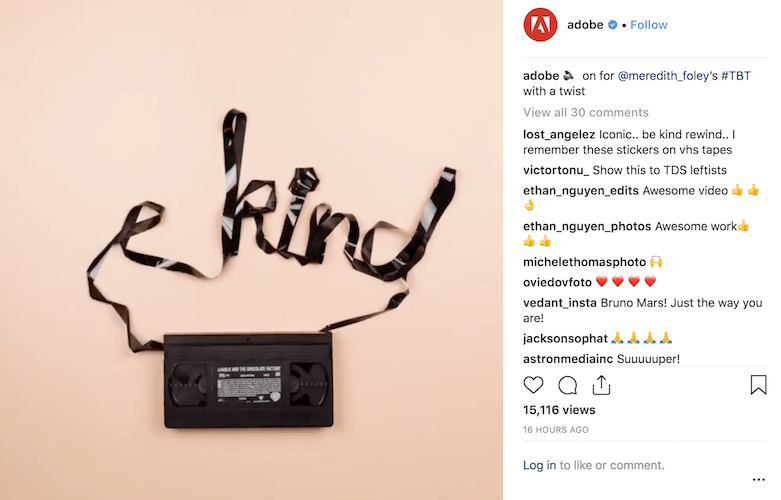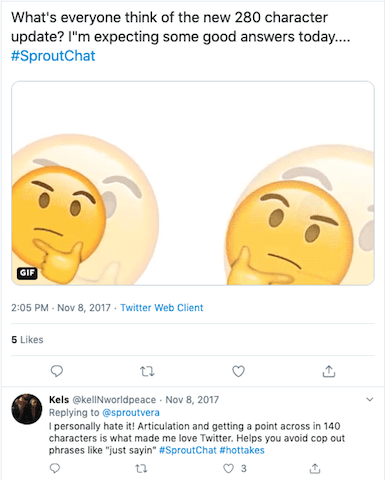It’s no secret that consumers and B2B buyers trust user-generated content (UGC) more than brand-generated content. When it comes to purchase decisions, buyers simply place more stock in the information and recommendations they receive from their peers.
The influence of UGC is growing across all social channels. So, it’s important for B2B marketers to consider the role UGC plays in their brands’ marketing strategies — and the first step is to gain a better understanding of the various benefits UGC provides to B2B brands.
1. User creativity drives increased customer engagement.
UGC introduces opportunities for added depth and creativity, resulting in a 28% higher engagement rate than standard brand posts. For example, in Adobe’s CreateJoy campaign, users share images, animations and videos they’ve created using Adobe, then include the hashtag #Adobe_CreateJoy for their content to be featured on Adobe’s social networks.
This allows the brand to inspire buyers by showcasing the creative talent of its users — talent that’s enabled by Adobe products. Rewarding the creators of UGC with reposts or retweets motivates participation, especially for brands with a large social following. If your brand has a smaller following, offer an incentive such as a prize to boost social shares of UGC.

2. UGC gives your brands a voice in conversations your customers care about.
Encouraging your audience to share their views and ideas on a topic they care about can be a powerful, mutually beneficial social strategy. By initiating meaningful conversations with prospects and customers, you can position your brand as an influential voice and thought leader in the space.
Start by posing an industry-specific question and encouraging discussion in the comments section of the post. The responses you capture from your social audience can inform decision-making and potentially be repurposed for stand-alone social content or the development of other content assets.

3. Customer success stories connect prospects to the customer journey.
In addition to driving higher engagement, UGC also builds and strengthens customer loyalty. Today’s buyers have the ability to research and review a product on their own, but they are more likely to trust a user’s review of a product over a brand. That’s why 93% of consumers find UGC helpful when making a purchasing decision.
Third-party review sites like Yelp, Google, TrustRadius or G2 are the most valued because they are not hosted or controlled by a brand. However, video testimonials are still powerful when hosted on a brand platform because they facilitate a more playful approach to storytelling. For a prime example, check out this video made by Slack customer, Sandwich Video.
This testimonial blends video and animation to showcase how the product addresses customer pain points in an entertaining and unique way. Viewers can relate to the customer journey and see how Slack might also benefit their businesses.
4. Employee UGC generates positive brand sentiment.
Company culture posts are a form of UGC that drives high engagement rates and differentiates your company from competitors. Consider sharing content created by your employees, like an inside look at a day in the life of your marketing manager and employee-generated blog posts. Or consider allowing employees to take over your brand’s social channels. This creates distinct and memorable content that serves as the building blocks of your brand’s online image.

You’ll notice that this content differs from the content in an employee advocacy program in which workers are given content to share on their own social media channels. Mailchimp takes advantage of UGC through its #MeetMailChimp series where they introduce and feature employees on Instagram. Employees are empowered to share their positive work experiences, which boosts public brand perception, as shown in one comment, “I want to work for MailChimp, sounds awesome”.
User-generated content will continue to be a driving force on social platforms as B2B brands move away from a strict sales approach and tap into new audiences. Sharing UGC shows customers and employees that a brand values their voices and opinions, creating a stronger and more loyal online community. A UGC strategy acts as a powerful endorsement for a brand and its products, creating a level of trust which transcends any paid social efforts.
Is your brand taking advantage of UGC? If not, it should be. User-generated content is a foundational element in B2B social media strategies and Walker Sands is here to help. Connect with our social media strategists today and let’s start a conversation about how you can use UGC to your brand’s advantage.



